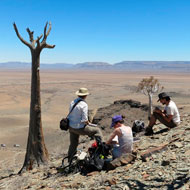The ancient reef is now located on dry land in Namibia.
Research dates ancient reef to 550 million years ago
A recent study, led by researchers at the University of Edinburgh, has revealed how one of the Earth’s oldest reefs was formed.
The survivor of an ancient aquatic world, the reef is thought to have been built 550 million years ago by what are thought to be the first animals to have had hard shells, and is now located on dry land in Namibia.
A process called biomineralisation caused the development of hard, biological structures, allowing animals to fix to each other and to surfaces by producing natural cement.
This is thought to be a response to increasing selection pressures, as the reef allowed the tiny creatures to gain access to nutrient rich currents and living space, at a time when resources were scarce.
The filter feeding organisms, known as Cloudina, lived on the seabed during the Ediacaran Period, which ended 541 million years ago. Prior to the emergence of Cloudina, animals had soft bodies.
Professor Rachel Wood of the University of Edinburgh’s School of GeoSciences, who led the study, said: “Modern reefs are major centres of biodiversity with sophisticated ecosystems. Animals like corals build reefs to defend against predators and competitors. We have found that animals were building reefs even before the evolution of complex animal life, suggesting that there must have been selective pressures in the Precambrian period that we have yet to understand.”
The research has been published in the journal Science, in collaboration with University College London and the Geological Survey of Namibia. It has been supported by the Natural Environment Research Council, University of Edinburgh and the Laidlaw Trust.
Image courtesy of Rachel Wood.







 The BSAVA has opened submissions for the BSAVA Clinical Research Abstracts 2026.
The BSAVA has opened submissions for the BSAVA Clinical Research Abstracts 2026.
